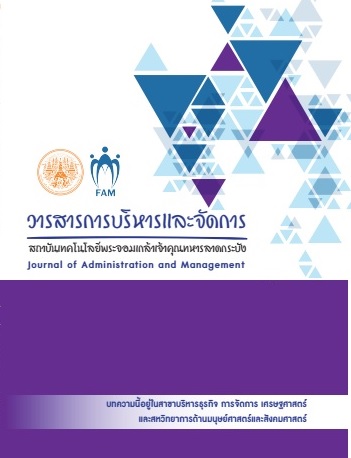SERVICE MARKETING MIX AND CUSTOMERS’ PERCIVED VALUE INFLUENCE TO CUATOMER LOYALTY OF HEALTHY FOOD RESTAURANT CHON BURI PROVINCE
Main Article Content
Abstract
The objectives of this research were to study Service marketing mix and Customers’ perceived value influencing to customer loyalty of Healthy food restaurant, Chon Buri province. Samples were 400 customers have experience about healthy food restaurant. The results of the research showed that the level of Service marketing mix, Customers perceived value and Customer loyalty were high. Promotions of service marketing mix influenced to customer loyalty (repeat word of mount, intention, price tolerance and complain behavior). In addition people influence to customer loyalty (repeat, price tolerance and complain behavior) and physical evidence influence to customer loyalty (repeat, word of mount, intention and price tolerance). Customers’ perceived value influenced to all of customer loyalty with significance at the statistics level 0.05
Article Details
Journal of KMITL Business School is available both online and in printed version.
**All articles or opinions presented in this issue of the Journal of KMITL Business School reflect the thoughts of their respective authors. This journal serves as an independent platform for a variety of viewpoints. Authors bear full responsibility for the content of their articles.**
**All articles published in this journal are copyrighted by KMITL Business School, King Mongkut's Institute of Technology Ladkrabang. The editorial team permits copying or using articles, but a reference to the journal is required.**
References
__________. (2560). ธุรกิจภัตตาคาร/อาหาร. สืบค้นเมื่อ 24 กันยายน 2560, จาก http://www.dbd.go.th/download/document_file/Statisic/2560/T26/T26_201703pdf
ชัยสมพล ชาวประเสริฐ. (2546). การตลาดบริการ Service Marketing. พิมพ์ครั้งที่ 13.กรุงเทพมหานคร: สำนักพิมพ์ซีเอ็ดยูเคชั่น.
บัณฑิตวิทยาลัย จุฬาลงกรณ์มหาวิทยาลัย. 2553. สะกดรอยกระแสนิยม "อาหารสุขภาพ" คนไทยทุ่ม 8,000 ล้านต่อปีเพราะอะไร. สืบค้นเมื่อ 29 กรกฎาคม 2560. จาก http://www.grad.chula.ac.th/download/e-articles/food.pdf
ปฎิมาภรณ์ สุขสมวัฒน์.( 2556). คุณค่าการรับรู้ที่มีผลต่อความจงรักภักดีของลูกค้าในการใช้รถยนต์ติดตั้งก๊าซในเขตจังหวัดนครราชสีมา. สืบค้นเมื่อ 29 กรกฎาคม 256, จาก http://www.narinet.in.th:8080/xmlui/handle/123456789/290
พริมา อัครยุทธ. (2015). 5 เทรนด์อาหารและเครื่องดื่มที่กำลังมาแรงและน่าจับตามองในอนาคต. สืบค้นเมื่อ 29 กรกฎาคม 2560, จาก https://www.scbeic.com/th/detail/product/1277
พิบูล ทีปะปาล. (2545). หลักการตลาด : ยุคใหม่ในศตวรรษที่ 21. กรุงเทพมหานคร: สำนักพิมพ์มิตรสัมพันธ์กราฟฟิค.
รณชัย ตันตระกูล. (2553). การบริหารจัดการการตลาด (Marketing Management).กรุงเทพมหานคร. สำนักพิมพ์ ซีเค แอนด์เอส โฟโต้สตูดิโอ.
ราชบัณฑิตยสถาน. (2525). พจนานุกรมฉบับราชบัณฑิตยสถาน พ.ศ. 2525. กรุงเทพมหานครฯ: สำนักพิมพ์อักษรเจริญทัศน์.
ฤดี หลิมไพโรจน์. (2552). การตลาดบริการ. ปทุมธานี: สำนักพิมพ์มหาวิทยาลัยกรุงเทพ.
วิทวัส รุ่งเรืองผล. (2556). หลักการตลาด. กรุงเทพมหานคร: สำนักพิมพ์มาร์เก็ตติ้งมูฟ.
วีรวุธ มาฆะศิรานนท์. (2542). การทำตลาด 23 วิธี. กรุงเทพมหานคร: สำนักพิมพ์เอ็กซเปอร์เน็ท.
ศิมาภรณ์ สิทธิชัย และ สิญาธร ขุนอ่อน. (2558).การวัดความภักดีของลูกค้าสำหรับธุรกิจโรงแรม. วารสารนักบริหารราชภัฏสุราษฏร์ธานี, 35 (1): 66-70.
ศิริวรรณ เสรีรัตน์ และคณะ. (2535). กลยุทธ์การตลาด. กรุงเทพมหานครฯ: สำนักพิมพ์พัฒนาศึกษา.
__________. (2552). การบริหารการตลาดยุคใหม่. กรุงเทพมหานครฯ: สำนักพิมพ์ธรรมสาร.
ศิวฤทธิ์ พงศกรรังศิลป์. (2555). หลักการตลาด. กรุงเทพมหานคร: สำนักพิมพ์ท้อป.
สำนักงานกองทุนสนับสนุนการสร้างเสริมสุขภาพแห่งชาติ. (2559). รายงานสุขภาพคนไทยปี 2559. นครปฐม: สำนักพิมพ์อมรินทร์พริ้นติ้งแอนด์พับลิชชิ่ง.
สำนักนโยบายและวิชาการสถิติ. (2555). เทคนิคการเลือกตัวอย่าง. สืบค้นเมื่อ 23 กันยายน 2560, จาก http://service.nso.go.th/nso/nsopublish/Toneminute/files/55/0203-5.pdf
สิทธิ์ ธีรสรณ์. (2552). การสื่อสารทางการตลาด. กรุงเทพมหานคร: สำนักพิมพ์แห่งจุฬาลงกรณ์มหาวิทยาลัย.
สิริกุล ประเสริฐสมบูรณ์. 2558. “โมเดลกลยุทธ์การตลาดบริการของร้านอาหารฮาลาลไทยเพื่อเตรียมความพร้อมสู่ประชาคมเศรษฐกิจอาเซียน”. วารสารบริหารธุรกิจ ธรรมศาสตร์. 38 (145): 65-81.
สุมนา อยู่โพธิ์. (2532). ตลาดบริการ. กรุงเทพมหานครฯ: สำนักพิมพ์มหาวิทยาลัยธรรมศาสตร์.
อดุลย์ จาตุรงคกุล. (2550). พฤติกรรมผู้บริโภค. พิมพ์ครั้งที่ 2. กรุงเทพมหานครฯ: สำนักพิมพ์ มหาวิทยาลัยธรรมศาสตร์.
Gliem, J. A., and Gliem, R. R. (2003). Calculating, interpreting, and reporting Cronbach’s alpha reliability coefficient for Likert-type scales. Midwest Research to Practice Conference in Adult, Continuing,andCommunity Education, retrieved October 6,2010, from http://hdl.handle.net/1805/344
Joseph F. H. et al. 2006. Multivariate data analysis. 6th ed. New Jersey: Pearson Education International.
Ivanauskiene, N., & Auruskevicien, V. (2009). “Loyalty programs challenges in retail banking industry”. Economics & Management 14: 407-412.
Jahyun, S. 2014. The Role of Perceived value and Emotion in determining consumer satisfaction and loyalty: A case of Asian restaurants. Master of Science Thesis in Human Sciences, Oklahoma State University.
Kotler, P. (1997). Marketing management: analysis, planning implementation and control. (9th ed). New Jersey: Asimmon & Schuster.
Porter, M. E. (1980). Competitive Strategy: Techniques for Analyzing Industries and Competitors.
Sweeney, J. C. and Soutar, G. N. (2001). “Consumer perceived value: The development of a multiple item scale”. Journal of retailing 77 (2): 203-220.
William, G.Z. 1997. Research Methods. Forth Worth: Dryden Press.
Zeithaml, V. A., et al. (1996). “The behavioral consequences of service quality”. Journal of Marketing 60: 31-46.


